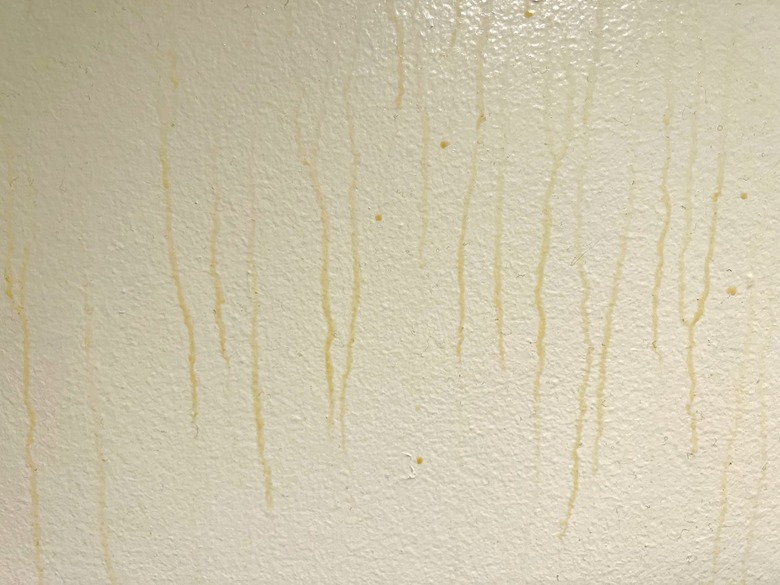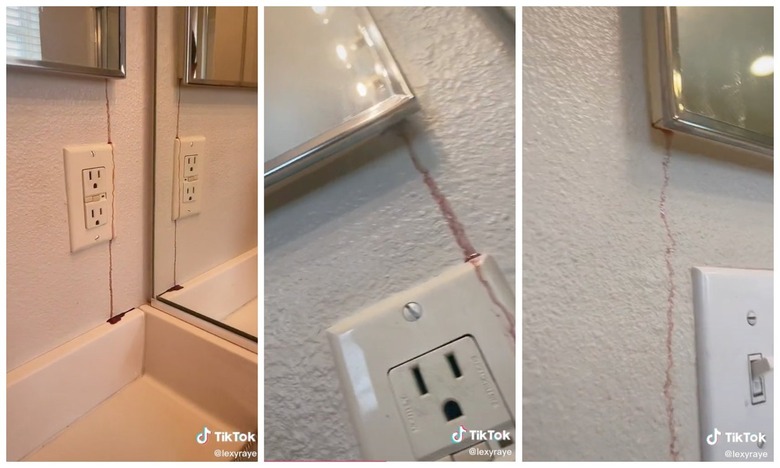The Non-Demonic Reason Why Your Walls Might "Bleed"
Have you ever noticed creepy-looking brownish drips rolling down your bathroom wall? Fortunately, it's (probably) not some sort of demonic activity. There's actually a relatively common reason that your walls "bleed" like this, and it's called surfactant leaching.
"Surfactants are soap-like molecules added to paint to help ensure good incorporation of color pigments and uniform color on the finished wall," Karen Rechenberg, technical manager of latex paints at PPG Architectural Coatings, the makers of Glidden paint, tells Hunker. "After paint is applied, surfactants naturally migrate towards the surface of the paint film."
What Does It Mean When Your Walls Bleed?
Under normal circumstances, the paint won't bleed because it dries before the surfactants reach the surface, but there are two conditions that could cause surfactant leaching.
The first is when paint is applied in a colder temperature than recommended. That could extend the drying time, meaning that the surfactants might be able to reach the paint's surface before it fully dries. In this case, the drips that result from surfactant leaching would appear pretty soon after a fresh coat of paint is applied.
"To avoid surfactant leaching, it is important to follow application guidelines regarding temperature and humidity conditions provided on the back label of the paint can," says Rechenberg.
The second situation that would cause surfactant leaching has to do with the type of paint used and the environment in which it's used. "If the paint is not made for high-humidity environments, the surfactants can leach completely," says Rechenberg. That commonly happens in bathrooms with poor ventilation and on home exteriors in humid or damp climates, resulting in those unsightly brown or amber drips.
Now, if your walls are bleeding a dark red, such as in this viral video by TikTok user @lexyraye, that's likely not surfactant leaching, but an entirely different problem. "The blood-like color is more than likely being caused by the mixture of rust and water, which could, in theory, give it that type of menacing hue," Diarmuid Hennessey, a home contracting expert with residential property service provider Homecheck in Ireland, tells Hunker.
After much exploration, @lexyraye determined that Hennessey's theory was correct — the culprit was rusted metal inside the wall cabinet. "This could be possible over time as moisture builds on the metal and then drips down post-shower," Kerry Sherin, a consumer advocate at homeowner data website Ownerly, tells Hunker.
However, there are other reasons why your walls might bleed a red hue. Sherin notes that algae could be the problem. "The damp environment in many bathrooms makes them the perfect place for algae to grow, especially if there is poor ventilation," she says.
Hennessy also shared an alternative cause of the red drips that does feel like it's straight out of a horror film — old razors stuck in the wall. "From looking at the video, it appears that there is an old-fashioned razor slot in the cabinet, where old razor blades would've been discarded," he says. "That means there's definitely a stack of old, rusty razors just sitting behind the cabinet. If there is any form of a leak behind the cabinet, that would explain the coloring."
How to Fix Paint Bleed on Walls
Whether your walls are suffering from surfactant leaching or from a rust situation, the key to avoiding long-term staining is to act quickly to clean up the mess.
On exteriors, you can hose down walls to wash away surfactant leaching (in some cases, rain might do this for you), but interiors will require a little elbow grease. "If leaching happens on the interior, wipe the walls gently with a soft, non-abrasive wet rag — water only — to try to remove the marks," says Rechenberg.
If you are dealing with rust, you'll want to remove whatever is rusty, be it razor blades or an old cabinet. In some extreme cases, it could be a corroded pipe behind your wall, too.
And finally, try to reduce humidity in your bathroom, as surfactant leaching can happen time and time again. If your bathroom has a fan, make sure it's clear of dust and debris so that it can operate efficiently, and keep it running after you shower to continue to remove humidity from the air. You can also try using a dehumidifier or a moisture absorber like DampRid.

